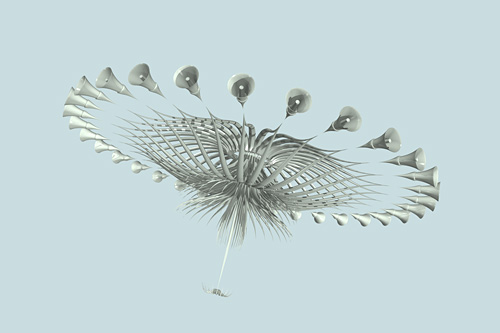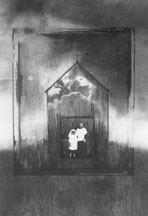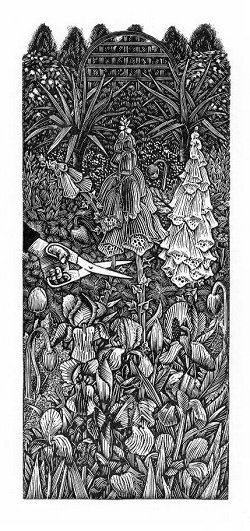
essay
link
Arts news, exhibitions, events, biennials and conferences, calls, resources and opportunities, technical information, exhibitions and reviews. London Edition.




Laura Ruby, a printmaker whose works will be exhibited in the Denison University Art Gallery starting on Friday (Feb. 21), will visit Granville to meet guests at the opening reception and to work with students during her stay.She will open her visit with a lecture about her artwork at 7:30 p.m. on Thursday (Feb. 20) in the Cleveland Annex (Mulberry Circle).
Ruby has created the "Nancy Drew Series," silk-screen prints that parody the concept of the mystery novel. A resident of Hawaii, Ruby's prints are rich with integrated literary allusions, along with cultural and artistic metaphors that are intended to give the viewer clues associated with the title of the piece. Ruby also will be working in the Cleveland Hall print studio during the weekend creating a work which will become part of the Denison Library collection.
-----------------------
article
"Breaking New Ground: Explorations in Digital Printmaking" showcases a variety of approaches artists are taking in digital printmaking.
article
Laura Ruby paints a giant gecko that will be displayed with 49 others during Geckos In Paradise, a charity event and art exhibition organized by Kapi'olani Health Foundation, the fund-raising arm of Kapi'olani Medical Center. Ruby's fiberglass lizard is five feet long and weighs 35 pounds.

The New York Society of Etchers, Inc., in conjunction with Gallery 101, of Melbourne Australia, presented “Contemporary Australian & New Yorker Prints” at the National Arts Club in New York City. Curator Cynthia Reeves of Reeves Contemporary Gallery, Chelsea selected the 34 New York printmakers who are from diverse locations in and around New York State. The prints presented have been selected by juried entry on behalf of the New York Society of Etchers inc. (NYSE).
Australian co - curators of the show are Dianna Gold and Dr. Carmel Wallace. The prints selected offer a wonderful glimpse into printmaking practice Australia-wide, from artists working in major cities such as Melbourne and Sydney, to those in very remote outback localities like the Western Desert. There are six indigenous printmakers represented alongside artists working in major rural / regional and city areas. The resulting body of work is a survey not only of intaglio printmaking in technical terms, but also of the ways in which Australian artists explore notions of identity as they respond to particular environments and cultural influences.
The show has been well received and has had recognition in major international publications including, Asian Art News, The International Print Journal, Poster and Monument Magazine. Imprint Magazine – published in Australia will also feature an article about the combined exhibition in their Summer 2004 Edition, Volume 39, Number 4.
There is a comprehensive catalogue and poster for the Australian component of the exhibition together with a catalogue produced by the NYSE.
The Australian component of the exhibition: Surface Tension Twenty One Contemporary Australian Printmakers will be shown at the Academy Gallery of The University of Tasmania from 11 February – 13 March 2005.

Surface Tension exhibition opening crowd
Academy Gallery, 2005
Australian participating artists are:










"Juli Haas employs allegorical imagery to create a fantastic and ambiguous world through which she can provide a commentary on social behaviour, particularly on the role of women in contemporary society. The surreal dream-like imagery, laced with wit, whimsicality and a latent eroticism, creates a popularly accessible visual language, rich in its theatricalism, vibrant colours and dramatic appeal" *Sasha Grishin "Australian Printmaking in the 1990's"
------------------------------------------------------
Juli Haas, highly successful Melbourne based watercolourist and print-maker, has exhibited in over 100 countries and has been awarded the Sir John Sulman Prize, the Silk Cut Award, the Shell Art Prize, the Acquisitive Award by the Hawaii State Foundation, and numerous others.
Her highly distinctive & rich imagery is in the collections of the National Gallery of Australia, the Art Gallery of South Australia, Queensland Art Gallery, Art Gallery of NSW, numerous regional galleries, and private and corporate collections throughout the world.
Haas’s artwork can be dark and menacing, but there is also a strong undercurrent of humour and irony. Entire stories seem to be contained within a single image- her famously detailed pictures engaging the viewer within a world in which there is always something new to observe. So much is packed into a single painting or print. Haas is one of those artists for whom the imagination is an endless supply of inspiration.

"Haas, 53, left her art degree unfinished in the '70s, did odd jobs, got married, had three children and then returned to study in the '80s where she completed a masters of art at Monash University. She has had several solo exhibitions here and overseas and contributes to exchange folios where up to 40 artists put in prints for collections. The day of the interview she received a box of prints, including one of hers, from the State University of New York, which will exhibit and tour the collection that has as its theme, Walking On Water."--------------------------------------------


Made Known
18th sept - 18th oct
Rapid prototyping is a 3D printing technique where objects are 'printed' by extruding liquid material, adding one slice on top of another. The material then hardens, resulting in a solid 3D model.
The works in Made Known represent an international cross-section of artists who have embraced the potentials of 3D printing to create sculptural objects. Artists from Australasia, Europe and the US have been invited to send a piece of work via the Internet as a 3D digital file. These files will be printed as rapid prototype objects using the 3D printing facility in the School of Design at UTS.
In addition to 3D prints, animations using the same rapid prototype software will feature in the exhibition by artists including Hye Rim Lee, Marcus Williams and Susan Jowsey.
Curated by Ian Gwilt and Brit Bunkley.
UTS Gallery The art of Fiona Hall and Fiona MacDonald will turn the gallery into an environment where we see the aftershadows of the collection and the complicated folds of capitalism. The setting is a haunted domesticity. The walls are draped and wallpapered, shopping bags frighten us and all our money seems able to blow away. But this is not a simple horror. We experience the paradoxical pleasures of seeing money made into an exquisite home and flows of consumption becoming a sail across the sea or a flight on a breeze.
Level 4 702 Harris St
Ultimo Sydney NSW 2007
------------------------------------------------------------------
Fiona MacDonald American Raptors (detail) 2002
Strangely Familiar
Fiona Hall and Fiona MacDonald
1 nov - 2 dec
We comfort ourselves as best we can. We feather our nests and are kissed by consumption. We are flying toward something we do not know and yet someone, somewhere, always knows where we are.



East Anglian wood engraver (member of Society of Wood Engravers, Wood-Engravers Network USA). Work mainly independent limited-edition prints (each one an original artist's print numbered and signed) or illustrations. Also bookplates. Themes: childhood, gardens, the Fens, relationship between people and rural environment. broughton house
Wood Engraver - Studio diary
--------------------------------------------------------
A very nice presentation of John Keats poem with wood engravings by Andy English. Bugra endpapers. Poliphilus and Blado with Goudy Text for display in violet and black on Zerkall Book White Wove. 7 by 5 inches [178 by 127mm]. 36 pages. Quarter violet cloth and decorated printed paper over boards, with spine label. Frontispiece, two smaller engravings within the text, a tailpiece, and the press device are by Andy English. Edition of 115 copies.
http://www.califiabooks.com/finepress/b/barbarian.html
"The Hidden Pool" Woodengraving
The Hidden Pool, like almost all of my work, relates to a place that has special significance to me. I pass these trees most days. They make a graceful group. However, if one walks across the field to reach them, there is a small pool of water and the mood changes to a hidden and mysterious spot. I could not find a large endgrain block that I could afford where the wood was proven to come from a sustainable source so, rather than make the print smaller, I engraved on a from Lawrences of London, which I built up to type high with mdf.Characteristics of the American printmaker (now based in Paris and Oxford) Jean Lodge’s work are constant innovation, an extraordinary mastery of mixed techniques and a fascination with the human face. She was for 17 years Head of Printmaking at the Ruskin in Oxford, and has spent time in Japan with hand papermakers and printmakers. Now she concentrates on her own work, while giving workshops in the USA, in her Paris studio and on behalf of the gallery at our northern outpost at Castle Farm in Arkengarthdale.
from broughton house

 |
| |

today. 18:00 - 21:00
exhibition invitation & details

Iwhat?I.whats the point, its a studyish kinda thing

-------------------------------------------------------
Picked up an exhibition invite in the cafe yesterday and thought it looked worth a visit. The gallery is behind the noordekerk in noorderkerkstraat, and it turned out to be a pristine and attractive space.
I always enjoy work that is well drawn and this certainly was. With a very printerly limited palette, the exhibition is titled "white contrast", they were mostly paintings on white canvases. The work read well from an distance but drew the viewer in close to observe the fine detail and tiny drawings. Filled with visual quotations, the work invites a game of 'spot the reference', always fun at any exhibition.
A background in anatomical drawing and street art is apparent. Many of the works contained repeated imagery that may have been stenciled. Many of them are here on the website. http://menglef.org/
-------------------------------------------------------
more nathan on deviantART






In this print, Goyo hoped to achieve an image that conveyed the sense of solidity and volume from his drawings by using line and flat color without recourse to shading. The woman, kneeling beside a basin with her clothing folded nearby, wrings out a cloth to wash before entering the soaking tub. Her completely nude figure reflects Goyo's training in Western artistic practices such as drawing from life, which formed the basis of all his figure prints. Ultimately, Goyo was not satisfied with the result of his cooperation with Watanabe. Convinced that the artist should exert more control over the result, he turned to publishing his own prints after this single collaboration.





Xu Bing was already a famous artist in China with 'A Book from the Sky'. This is an Art project he worked on for years. Cutting thousands of ineligible characters in wood blocks and printing them in the old Chinese way. This work was exhibited in Beijing in February 1989 and got at first very positive reviews.
| Xu Bing and the Great Wall In May 1989 he was working on a new project. This is named 'Ghosts Pounding the Wall'. He spends twenty-five days in Jinshanling to make a rubbing of a part of the Great Wall. For this project he and his co-workers used 300 bottles of ink and 1300 sheets of rice-paper and tissue-paper. Special outfits were designed beforehand to wear during the work. During the time he worked on the Wall, photographs, videotapes and sound tapes were made. The result of all this enormous effort was 1000 square meters of rubbings. Rubbing A rubbing is a typical Chinese technique of making an imprint. A piece of paper is put on a surface and than rubbed with a ink pad. So the hollows are white and the rest is black. In this way you get a negative imprint of the surface. |
The local people consider this stretch of the Great Wall more or less part of their home, 'the side wall' as they call it. From that perspective they named the artist and his friends working on the rubbings 'paperhangers'. At first the locals never asked themselves what the use would be, and later on as local people were hired and worked with the artist nobody cared about the usefulness of this wallpapering.
Printing and its possibilities as the main theme for Xu Bing's work
Xu Bing was at that time a teacher of the Beijing Academy of Fine Arts and was specialised in graphic techniques. In an interview he explains his motives saying that he spends a lot of time thinking about the process of printing, considering al possible materials and ways of reproduction, and maybe most important to him the meaning behind al this. He tried all forms of printing. He remembered the many different shaped rocks in his home province that to him was the most impressive form of natures imprint. That vision gave him the idea to make use of the traces left by history and nature on the Great Wall, making it into a giant reproduction of former times.
Action printing and nonsense
To use his own words about this Great Wall project; the action is just as important as the result of the work. You can use almost anything with an uneven surface to make a rubbing. Bringing something as magnificent as the Great Wall from outside to inside gives people a very strong visual and emotional impulse. This is shocking for people and is the stronghold of Art. At the same time through the motion of the physical work, he wants to create an action art manifestation, saying that Art is the process that should solve peoples problems during any transition period. He is looking for a way to go through this transformation by putting in a tremendous physical effort and creating a result that is 'nonsense'.
Beijing New Wave or Chinese Avant Garde
Xu Bing is part of the Beijing New Wave. In Europe and America most people know this generation of Chinese artist under the name China Avant Garde because of the exhibition by that name in the early nineties. As I already told you after the exhibition of 'A Book from the Sky' in March 1989 he was praised for his renewals. Then after three months that is after the June fourth events in Beijing the same work was condemned for being 'nonsense' art or nonsensical art. 'Ghosts pounding the Wall' is another nonsensical work and the scale of this work of Art is overwhelming, just as overwhelming as the original structure the project it was based on; The Great Wall. The rubbings are mounted in the Chinese way and have never been shown in China.
In the West his work is open to all sorts of interpretation. I found someone saying that the word ghosts is a political statement because the word was used during the cultural revolution for counter-revolutionaries, which was a very bad thing to be at that time. The Western art-critic Britta Ericson places 'Ghosts pounding the Wall' in a heavy connection to the student uprising. Xu Bing and his work moving to the West, she says, altered the works meaning in ways Xu could not predict.
I have to put forward some historical facts about this. The first rubbing Xu made of the Wall was already done in 1987, and it is also obvious this had nothing to do with the 1989 events. The 1987 rubbing was by no means as big as this project, but the idea was already formed. I think the concept of the work was at that stage primarily concerned with the extremes of the printing process. In 1990 Xu Bing moved to America and in interviews he tends more and more to stretch the political meaning of his work. He also says that the intention of the Wall to keep strangers out is just as nonsensical as his own project.
Also in 1990 in China the art-critic Yin Jinan criticises 'Ghosts pounding the Wall', saying that because of the scale and the waste of manpower and the nonsensical meaning this is a work of art that can stir violent uprising. By saying this he underlines the political meaning of 'Ghosts pounding the Wall'. I think it is impossible to say if the political meaning was intended beforehand or that the political situation sort of took over after the work was made. The fact remains that in the early nineties both in the West as in China the work carried a political meaning next to its nonsensical meaning.
I even suspect another layer in Yin Jinan's writing. Although he writes critical about 'Ghosts pounding the Wall' he descibes the project beautifully. So if you filter out the critical part you end up with the best discription of it available in China.
...
And what happened to Xu Bing after making the 'Ghosts pounding the Wall'?
Xu Bing went to America in 1990 and became one of the representatives of the Beijing New Wave. He felt no longer free to work the way he wanted in his own country. The North Dakota Museum of Art installed the 'Ghosts pounding the Wall' in the summer of 1993 on a permanent base. Xu Bing is still working on Art projects which al have to do with the printing process. Sense or nonsense are present in all the works he did since. As far as the Great Wall is concerned it seems to me, it is not only keeping foreigners out but also some of China's own people.


